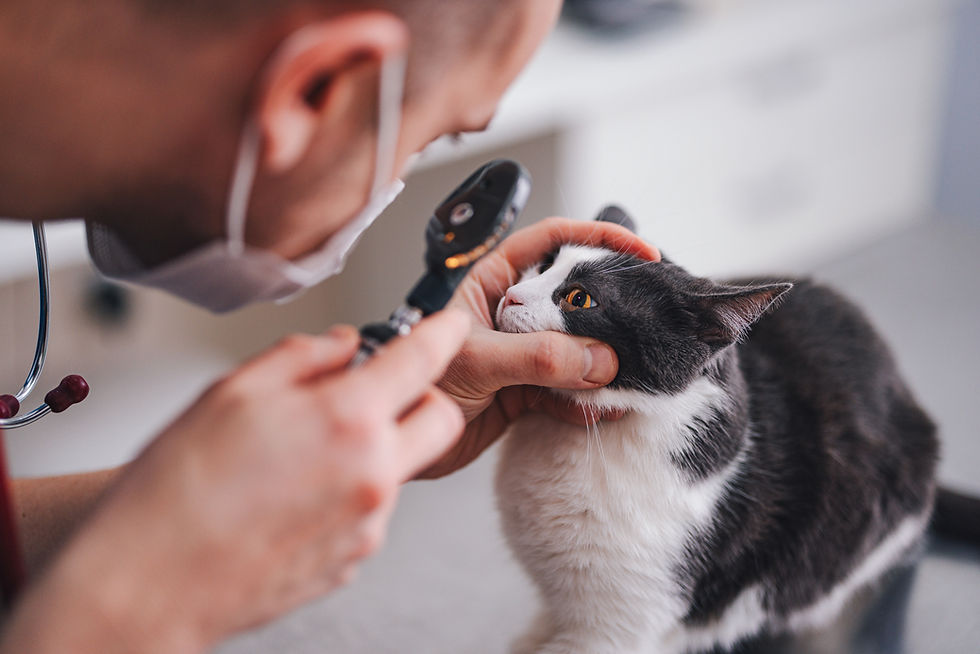Understanding Chemotherapy in Cats: What Owners Need to Know
- Carolyn O'Brien
- Nov 28, 2024
- 4 min read
When a beloved cat is diagnosed with cancer, a treatment option may be chemotherapy. While this treatment is often associated with human medicine, it can also be an effective palliative option for feline cancers, especially lymphoma, helping to manage the disease and improve your cat’s well-being. Here, we'll look into what chemotherapy entails for cats, how it works, and what to expect during the process.
What is Chemotherapy?
Chemotherapy is a type of cancer treatment that uses drugs to target and kill rapidly dividing cancer cells. In cats, chemotherapy is commonly used to treat cancers like lymphoma, which affects the lymphatic system, and other types like mast cell tumors, leukemia, and even some solid tumors. While chemotherapy may not completely cure the cancer, it can slow its growth, shrink tumours, and alleviate symptoms, all with the general goal of improving your cat’s quality of life, rather than curing the cancer.

How Does Chemotherapy Work in Cats?
In chemotherapy for cats, the medications can be administered in several ways, depending on the type and location of the cancer.
Treatments might involve:
- Oral medication: Pills given at home or in the veterinary clinic.
- Intravenous (IV) infusion: Medication delivered through a vein, often done in a hospital setting.
- Injectable treatments: Administered during an office visit.
The drugs used in chemotherapy are designed to target cells that grow and divide quickly, such as cancer cells. However, they can also affect normal cells that divide rapidly, like those in the gastrointestinal tract, bone marrow, and skin. The aim in feline chemotherapy is to strike a balance—minimising harm to healthy cells while effectively targeting cancer cells.

Will My Cat Lose Their Fur?
Unlike in humans, cats rarely experience noticeable fur loss from chemotherapy. Cats have a different hair growth cycle, so while minor thinning may happen, most owners won’t notice significant shedding. Whisker loss is also uncommon. However, some breeds like the Devon or Cornish Rex, which have unique coat types, may show more noticeable effects.
What Are the Side Effects of Chemotherapy in Cats?
One of the biggest concerns about chemotherapy are the potential side effects. The good news is that cats typically tolerate chemotherapy much better than humans or even dogs do. We adjust doses carefully to reduce the likelihood of severe reactions. Most side effects in cats are mild and manageable.
Common ones include:
- Mild gastrointestinal upset: Some cats may experience vomiting, diarrhea, or loss of appetite. These symptoms can often be managed with medications such as anti-emetics and/or appetite stimulants..
- Lethargy or tiredness: Your cat may seem a bit less energetic after treatments, but this is usually temporary.
- Lowered immunity: Chemotherapy can sometimes suppress your cat’s immune system, making them more susceptible to infections. We will monitor their blood work to watch for this and take precautions if necessary.
If side effects do occur, they tend to be short-lived, and your veterinary team will be ready to help manage them, ensuring your cat remains as comfortable as possible.

How Often Will My Cat Need Chemotherapy?
The frequency and length of chemotherapy treatments vary depending on the type of cancer, the drugs being used, and your cat’s overall health. Some chemotherapy protocols require weekly visits for several weeks or months, while others might be every few weeks. Our vets will work with you to develop a treatment schedule that’s best for your cat.
What is the Goal of Chemotherapy in Cats?
It’s important to understand that chemotherapy for cats isn’t typically about achieving a cure. The main goal is often palliative care, meaning it aims to improve your cat’s quality of life by slowing the progression of the disease, reducing symptoms, and potentially extending the time they feel good and enjoy life. While remission is possible for some cancers like lymphoma, in other cases, the goal is to control the cancer and provide your cat with as much quality time as possible.
What to Expect During and After Chemotherapy
We will monitor your cat closely throughout the chemotherapy process. This will include regular blood tests and physical exams to ensure your cat is handling the treatments well. If any concerning side effects arise, we may adjust the dosage or switch to a different drug. After chemotherapy, some cats may act a bit quieter or tired, but they should return to their normal selves within a day or two.
How Do I Decide if Chemotherapy is Right for My Cat?
Deciding whether or not to embark on chemotherapy for your cat is a deeply personal decision. It's important to consider your cat’s overall health, age, and quality of life. Together, we will discuss the prognosis and weigh the potential benefits and side effects of the treatment. Some cats respond incredibly well to chemotherapy and enjoy months or even years of good health after treatment, while others may not tolerate the therapy as well. We'll guide you through this important decision, ensuring that whatever choice you make is in the best interest of your feline friend.



